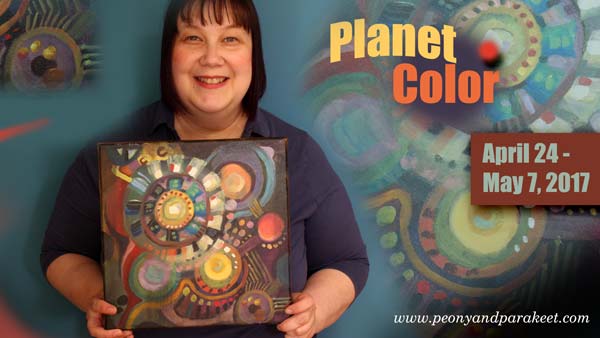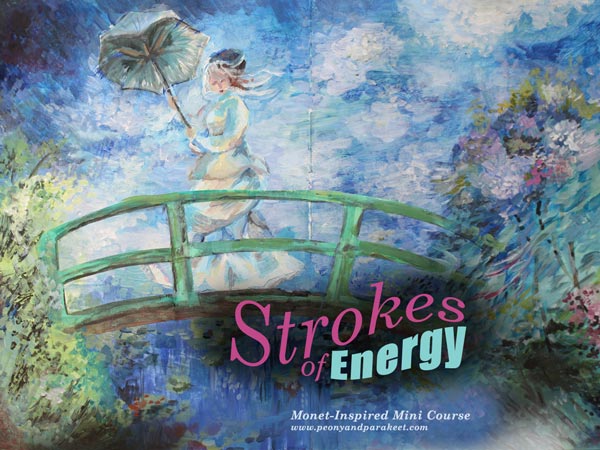Painting My Mind’s Eye – Abstract Color Fun!
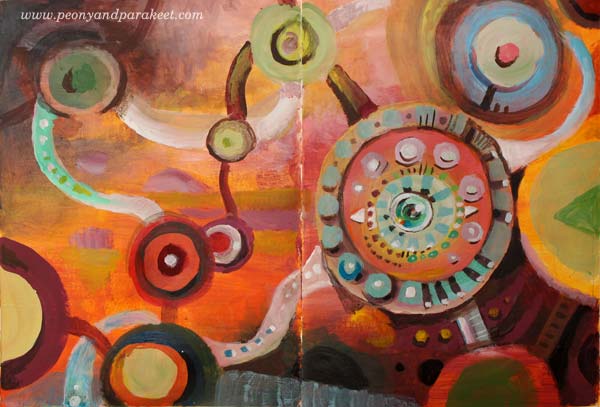
I call this art journal spread “My Minds Eye.” It has one central element that resembles both an eye and a compass. Isn’t that how things are for visual people: seeing interesting things evokes all kinds of thoughts and lead to all sorts of paths? Like this morning when I had to stop on a walk to admire fragile ice on water puddles. When I was standing there, I wished that nobody sees my weirdness. I was staring at the ground, holding a phone to get photos, with two beagles that were very impatient, eager to move forward.
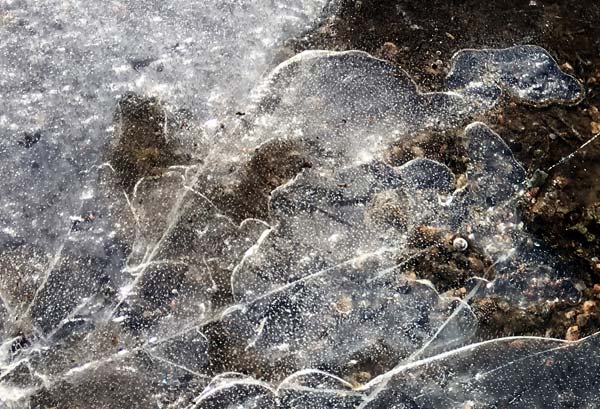
Maybe the beginning of the spring made me paint with hot tones, and the ice most probably inspired me to include a similar translucent element in the painting.
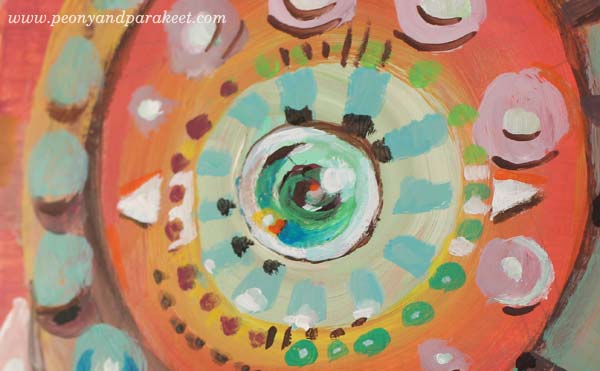
7-step Method of Planet Color Used for Abstract Color Fun
I created the spread by following the 7-step method that I developed for the class Planet Color. I have repeated this process many times because it’s a fun and worry-free way to paint unique abstracts. For example, see the blog posts What’s in a Good Composition?, Using Color Schemes for Home Decor, and How to Transform Ideas into Paintings. I know I am not the only one who worries about the composition while painting and the 7-step method makes everything fall into place effortlessly.
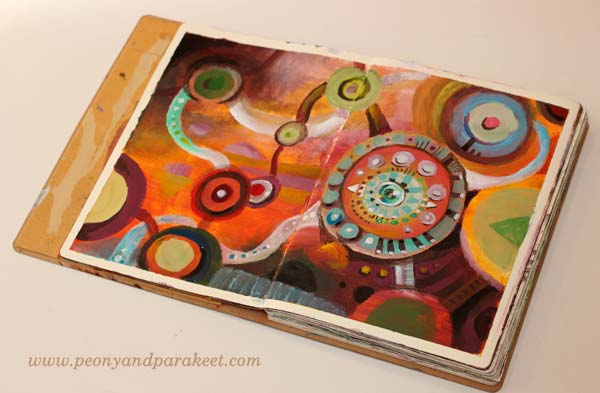
Masking tape was used to frame the piece. I haven’t done that a lot in my journals, but I like the result.
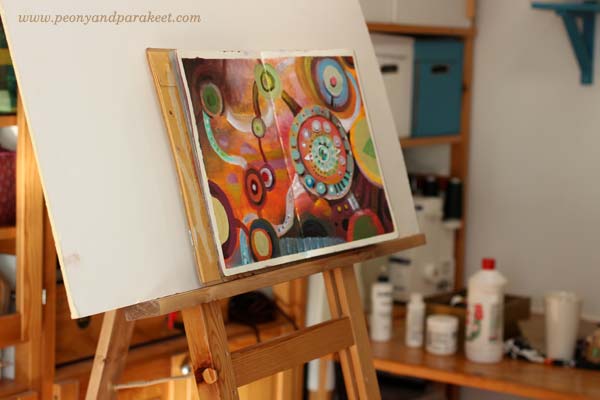
My husband made me a new easel from an upright support of a shelving unit. It’s so handy and adjustable that I have started to use it a lot. I can use it even for art journal pages, not only for canvas art.
Planet Color – Sign up Now!
I ran Planet Color for the first time last fall, but it’s coming back now! Whether you want to paint art journal pages, thick paper or canvases, this is a fun online workshop. It’s suitable for beginner painters and all who struggle with color compositions. >> Sign up here!
Rebuilding Art – Using Reference Images for Self-Expression
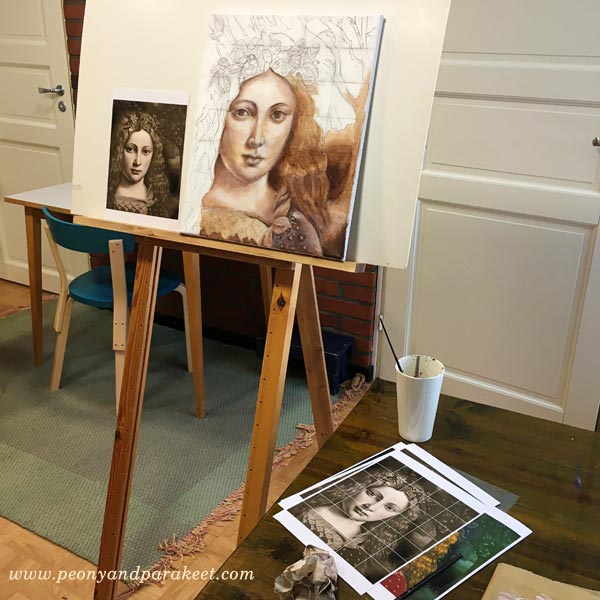
This blog post is about composing new art by using reference images. At the moment, I have a couple of paintings in progress that are based on reference images, and I also show other examples as well.
Why Don’t Artists Always Tell About Using Reference Images?
While painting my first oil painting at The National Museum of Finland, the visitors of the museum were able to visit the studio and watch us paint. Many people asked why we paint copies of the old paintings. The teacher Emmi Mustonen replied that it’s a good way to learn the old painting techniques and develop the understanding of formal elements. But I got the feeling that some of the people didn’t get it. Their facial expressions were imprinted on my mind, and it made me ponder why using reference images raises conflicting feelings.
Even if most artists who create realistic art or include realistic elements in their art, use reference images, many are not very open about it. I think that one reason is that many artists believe that people know that already and another reason that the process is not interesting. My experience is that there are surprisingly many people who assume that artists don’t take photos or use other than live models. And to me, the process of composing a new image from old ones is fascinating. I always stop to see an article where an artist shows how the reference images were used. I am especially interested if it’s about choosing the photos and combining several reference images into one piece.
Strawberry Madonna – Combining Several Reference Images to Tell a Story
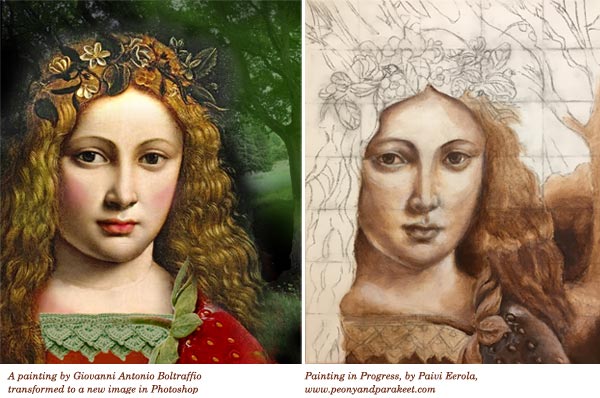
I am currently painting an acrylic painting on canvas that I call “Strawberry Madonna.” It’s my first using old masters’ painting techniques with acrylics instead of oil paints. The idea for the painting started differently than usually. I invented the title first and then started to think how Strawberry Madonna would look. I wanted to find a young woman who would have lips like she had just eaten a strawberry. By googling Renaissance paintings, I found Giovanni Antonio Boltraffio‘s painting. After that, I moved to building a story around the original idea.
Strawberry Madonnas are young girls who enjoy life without worries, have long summer holidays, eat strawberries, learn to crochet and read books like Emily of the New Moon or Anne of Green Gables. I have been one of them, and I feel quite nostalgic about it. I wanted the painting to include surrealistic elements. It has a big strawberry that is placed so that it could be a sleeve of the madonna’s dress. I am also going to change the flowers in the hair wreath to strawberry flowers and play with green and red paint. It will happen when I move on from underpainting to adding colors. In the background, there’s a photo that I took last summer. I am going to make it a little less detailed.
I used Photoshop to compose the reference image and made the sketch on canvas with charcoal. I drew a grid to make the sketching quicker.
Girl with a Ferret – Changing the Meaning with a Simple Trick
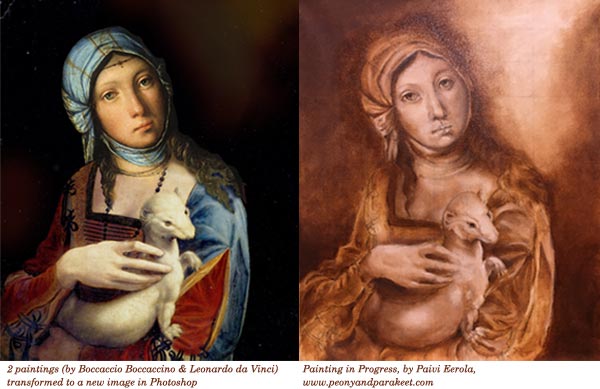
I have also started a new oil painting under the guidance of Emmi Mustonen. I got to pick the reference image freely. I wanted to pick an old Renessaince painting, but I couldn’t find any that would have a couple of my favorite features when painting with old masters’ techniques. I love to paint fur and fabric, and I wanted to find a face that would include openness. I fell in love with Boccaccio Boccaccino‘s portrait of a gypsy girl, but it didn’t have any fur. So I remembered Leonardo da Vinci’s “Lady with an Ermine” and created a new image by combining the two in Photoshop. I have several stories about this one.
The first one is about today’s society and how the pets have become more human in our eyes. I want to show the similarities in the wild gypsy girl and the tame ferret. Another story is about young girls and their love for taking care of animals. They might not know the wildlife, but they help to rescue animals and are ready to work hard when taking care of them. They are against fur clothing and not afraid to show it. The third story goes back to the 16th century. I imagine that the gypsy girl was hired to dress up and hold the ermine because the lady didn’t have the patience to pose for the artist. In the end, she never showed. The artist became frustrated and painted the girl instead. I can imagine the magical moment when the girl realized that she would be in the final painting instead of a lady.
I would like to talk with Boccaccio Boccaccino about my version. I also wonder, how he was able to paint the portrait of the gypsy girl when the artists mostly painted for churches and aristocrats back then.
At Monet’s Garden – Including All the Good Stuff to the Same Image
Last spring, I published a mini-course called Strokes of Energy as a part of the Imagine Monthly Spring series. I asked my students to name their favorite artists, and Claude Monet was among most popular ones. But when I thought about Claude Monet, I didn’t want just to serve those who love the garden or those who adore his way to paint the sky or those who want to express the windy scenes. I wanted to have all the good stuff in one image and then some more.
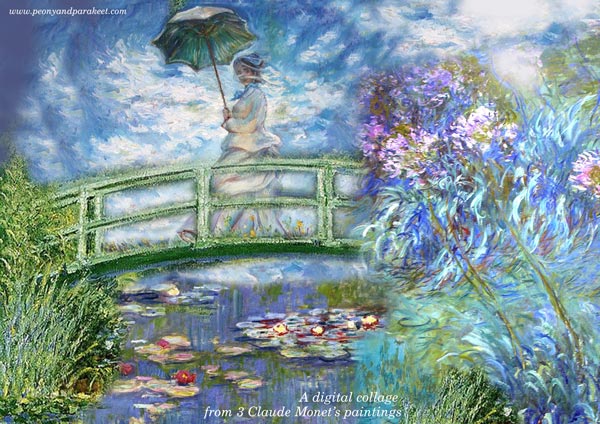
So I created a reference image in Photoshop combining three of Claude Monet’s paintings: “Woman with a Parasol” and a couple of paintings from the water lily series. Then I invented a technique where you can paint some of the elements as collage pieces so that you can adjust the overall composition before making the final decisions. This way it is possible to add more details one by one and improve the image during the actual creative process.
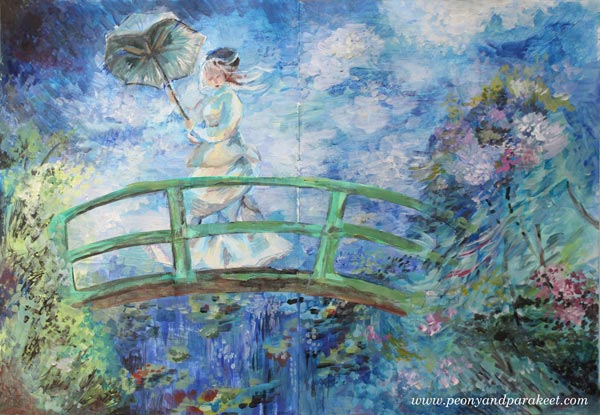
So this painting is about a woman who is experiencing strong wind. She doesn’t mind wind catching her parasol. She enjoys the fresh air and the beautiful scene around her.
Ulla’s Take
One of the students, Ulla M. Holm, made a Photoshop sketch from another set of Monet’s paintings and then painted the image with short impressionistic strokes. I love how the result also reminds me of her home country, Sweden!
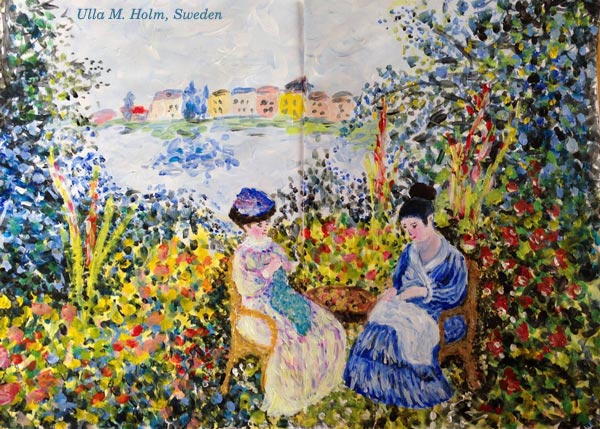
Using Reference Images More Intuitively – From a Story to an Experience
I admit having mixed feelings about following the reference images carefully. With my art, I want to express freedom, and I don’t think that following reference images too closely helps with that. On the other hand, I don’t want to restrict myself doing abstracts only or creating similar paintings one after another. Many artists create the same again and again and become better and better with that. To me, art is about exploring and the hook there is to widen my perspective continuously.
So even if you would prefer abstract art, it doesn’t mean you can’t have reference images. Instead of connecting with the actual story, you can connect with an emotional experience.

I picked colors and ideas from Emile Vernon’s painting and imagined what it would be like wearing that soft dress. The dress felt like a dream, so I wrote: “Muisto unelmasta” – “a memory of a dream” in the image.
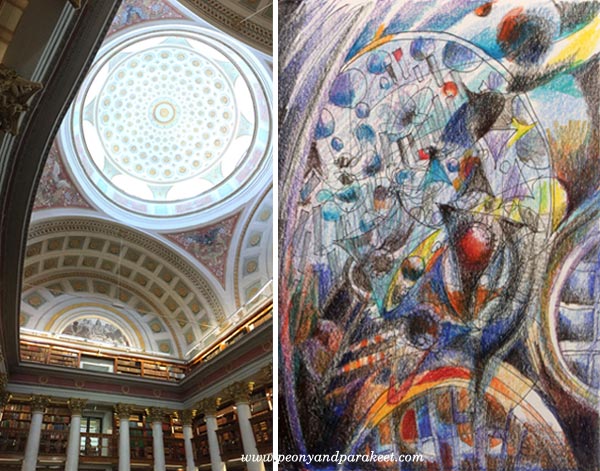
Here’s another example from my class Inspirational Drawing 2.0: a photo from The National Library of Finland and my interpretation, “The Power of Knowledge.”
Do yo want to experiment with this approach using your personal reference images? >> Sign up for Inspirational Drawing 2.0!
For the Fans of Monet – Strokes of Energy
My Monet-inspired mini-course Strokes of Energy is now available as an individual self-study course. >> Buy Strokes of Energy!
Geraldine’s Take
I want to end this blog post with a skilled artist Geraldine Norris from Australia who created her version of Monet in my class. She had just seen an art exhibition showing Monet’s work, and I think it shows how deeply she connected with the experience.
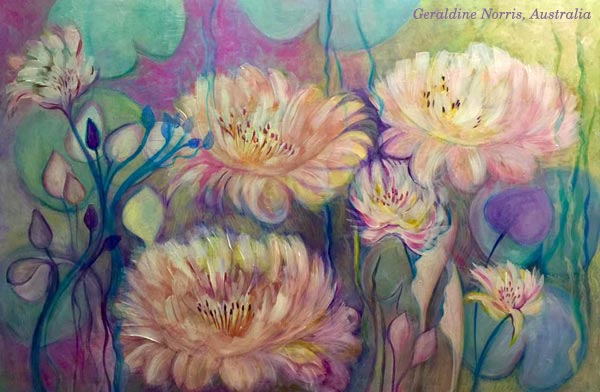
But wait, there is more beautiful Monet-inspired art from my students, see the presentation page of Strokes of Energy!
Until next time!
Intuitive Still Life with Gelli Plates and Golden Open Acrylics
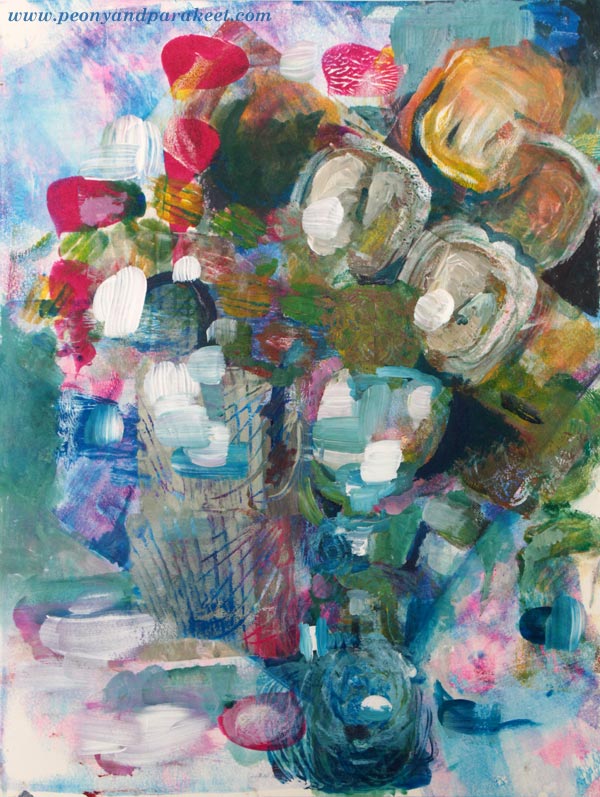
Here’s my latest painting, an intuitive still life with tulips. Last week, I had a short visit to an art supply store in Helsinki. I was surprised that they had a collection of Gelli plates for sale. When I got my first one several years ago, it wasn’t as accessible. I had to contact a shop in Italy which was the only retailer in Europe at that time. It’s great that Gelli plates have become more widely known. I have noticed that on my blog too. Month after month, the post “Self-Expression with Gelli Plate” is at top ten!
So I couldn’t help myself at the art supply store and bought another Gelli plate. My old one is 8 by 10 inches. The new one is a smaller, only 3 by 5 inches. It’s easier to handle and clean but mono printing with the big one is quicker.
Could Gelli Plates Be The Cure for Blank Paper Syndrome?
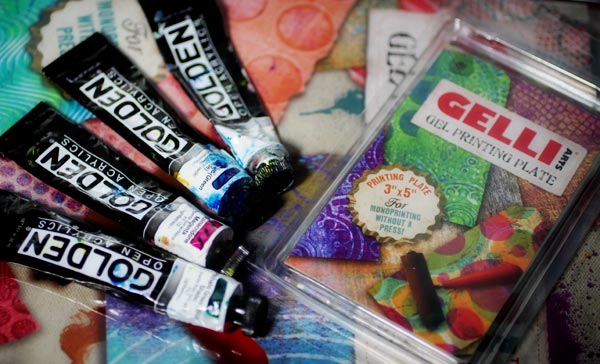
I wanted to have an experiment using both of the plates. Without any pre-planned idea about what my painting should represent, I would get over the blank paper syndrome using random monoprints. Then I would move on using brushes and working more intentionally. As always with mono printing, I used Golden Open Acrylics as paints because they don’t dry as quickly as regular ones.
Here’s my painting after I had some fun with Gelli plates.

And here’s the finished piece.
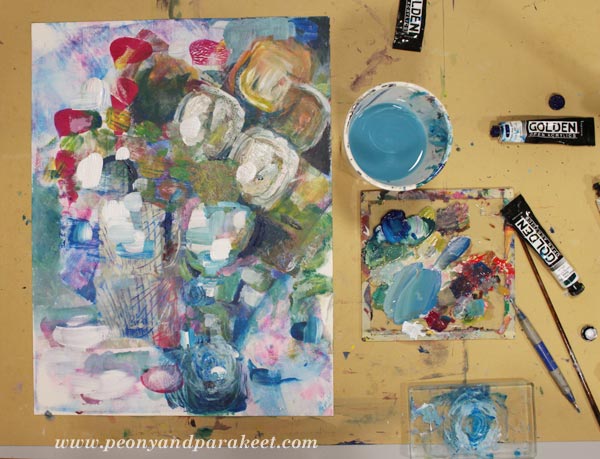
Intuitive Equals Subconscious!
After I had finished painting, I realized that it’s a combination of recent events: I got a lot of tulips for my birthday, made a strawberry birthday cake and enjoyed the winter sun with Stella.

Intuitive Still Life – Watch the Video!
Here’s a video about creating the intuitive still life. There you can see how adventurous my process was.
Enjoy creating more intuitively: Sign up for Inspirational Drawing 2.0!
Mixed Media Seascapes – 5 Tips for Expressive Art
Notice the new, useful categories for the blog posts, see the sidebar “Posts by Theme” or if you are in mobile, see the end of the page!
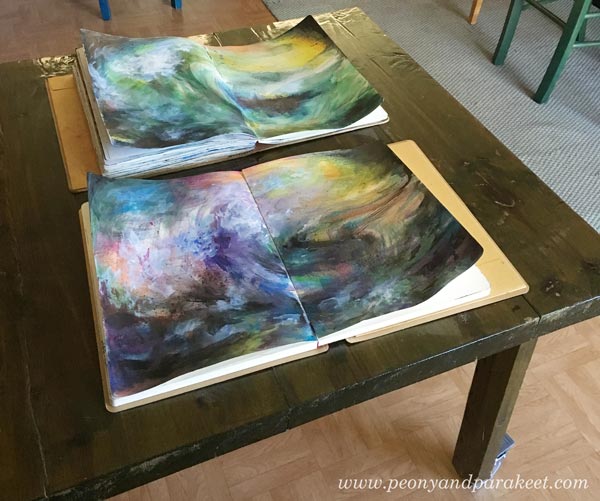
Sometimes I regret creating my art on the journals. When I created these mixed media seascapes for the mini-course Stormy Scenery, I wanted to keep the journals open and visible for days just to get back with the process and look at all the colors. And when I saw what my students had created, I secretly wished the same – that not so many weren’t in journals but frames. I want to share some art made from the mini-course and share some tips for expressive seascapes.
1) Play with Colors!
When creating the waves, show how the water reflects the colors of its surroundings. When there’s a storm, there will be a lot that’s moving, and it will affect the colors too. You can show your current state of mind as the sea and bring out the variety of thoughts and feelings. See how Claudia Watkins has made a row of waves with various colors.
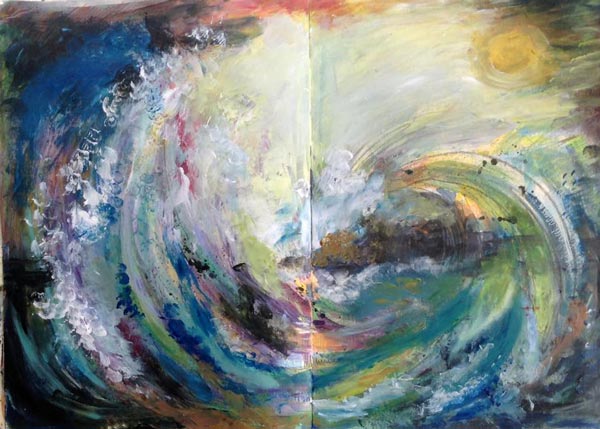
2) Create a Connection Between The Sky and The Sea!
If the sea represents you and the sky represents the outside world, how do they interact? Susan Rajkumar has expressed the connection in a brilliant way. It looks like the sea is willing to hug the sun and the overall feeling of the piece is warm and happy.
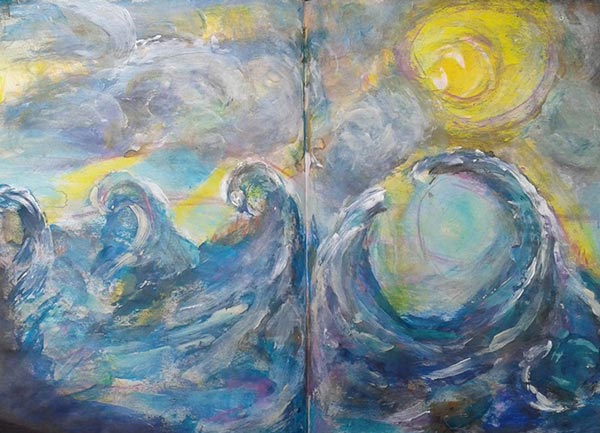
Sheila McGruer’s sun has left the sea, and it has caused an explosion of energy.
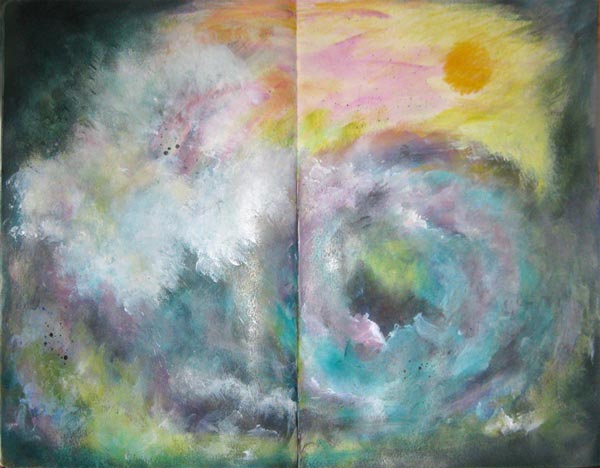
Sheila’s piece also has the softness which takes us to the next tip …
3) Express the Softness of Water
Cheryl Rayner shows the softness with both long strokes and splashes of water. With softness, you can practice gentleness towards yourself and others.
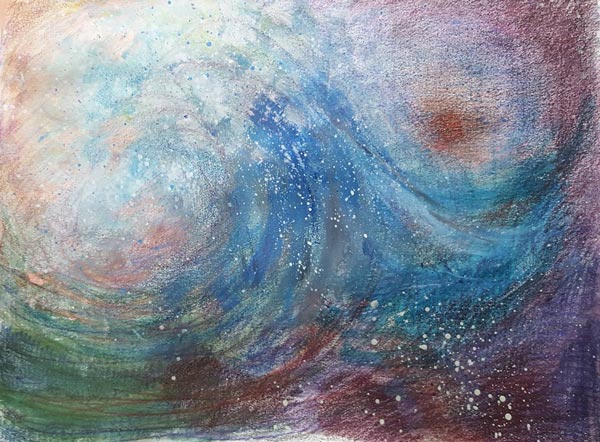
4) Show The Movement of The Waves
Enjoy the transformation that happens when you focus on creating art! Strokes and lines express the movement. Lorraine Cline’s green sea is captivating because it’s wonderfully dynamic!
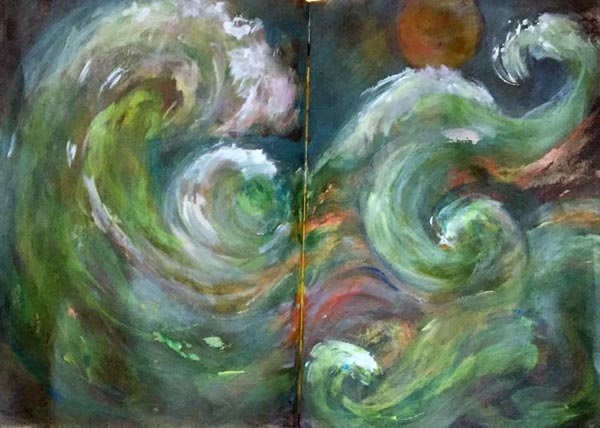
Terttu Laitinen has the great eye of the storm.
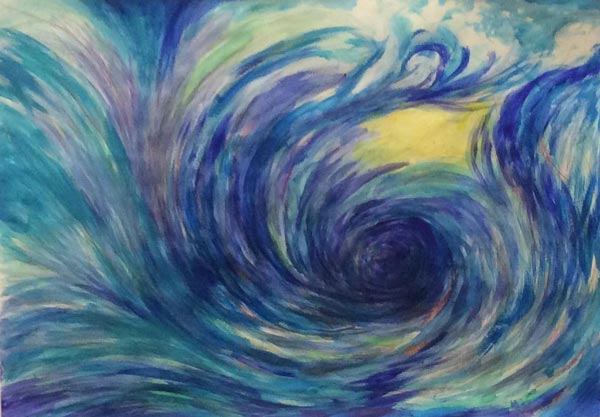
5) Make The Scene Look 3-Dimensional!
In any scene and any mind, some things are closer, and some things are further away. Add more 3-dimensional look to make some elements more blurry and some sharper than others. Satu Kontuvuori has a striking focal point where sharp white waves are on the top of the blurry black eye of the storm.
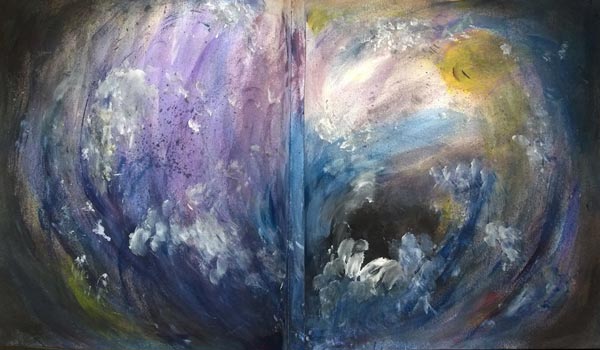
Mackie d’Arge also has a clear focal point and lots of less defined splashes around it.
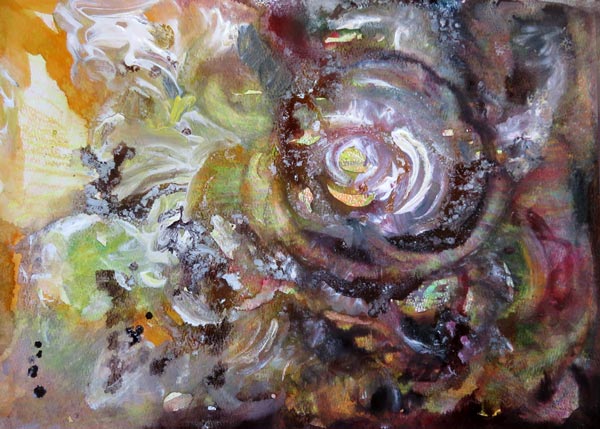
Internal Seascapes – Connect with Your Internal Energy!
The mixed media seascapes shown in this blog posts are made from the mini-course Stormy Scenery which was part of my Imagine Monthly Spring series last year. You can now purchase it individually too. When creating Stormy Scenery, I was inspired by the long chain of seascape painters, especially by J.M.W. Turner and Ivan Aivazovski. I also have a Pinterest board called Internal Seascapes where I have collected inspirational sea paintings.
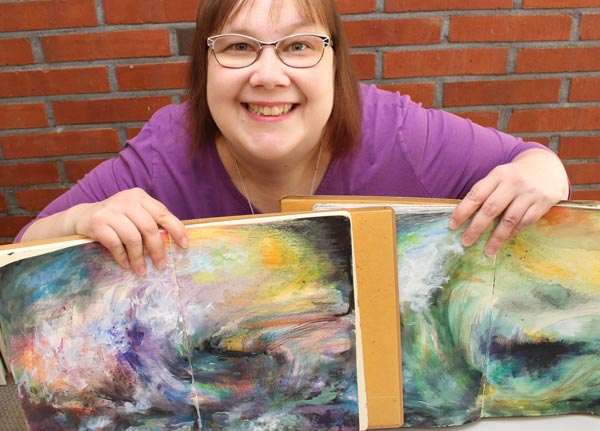
But in Stormy Scenery, more than just to paint the sea, I coach you through the process of opening up and bringing out your expression. With the mini-course, you are not so much mimicking the sea outside but expressing the power inside. I believe that every artist has a unique power as well as every day has a unique energy.
Create Mixed Media Seascapes!
Use colored pencils, watercolors, and acrylic paints to create expressive mixed media art!
>> Click here to buy Stormy Scenery!
